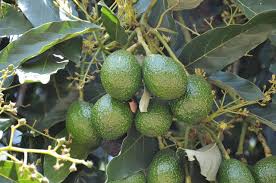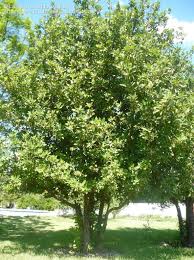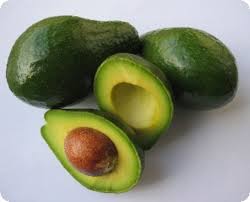Persea Americana Mill
| Botanical Name | Persea Americana Mill |
| Order: | Laurales |
| Family: | Lauraceae |
| Genus: | Persea |
| Species: | P. americana |
| Common Names: | Avocado pear, Alligator pear |
Plant Synonyms
Persea gratissima Gaertn F
Plant Local Names
NIGERIA: Yoruba - Pia, Hausa - Piya, Igbo - ube oyibo
Plant Habitat
Cultivated and occasionally naturalized.
Plant Material of Interest
leaf, bark, oil, seed, fruit
Plant Description
Tree is up to 18.29m high with large spreading and flat topped crown. Branches are grey and also fissured but the twigs are green and are smooth. Leaves, are ovate-elliptic to ovate-lanceolate 5- 20 (up to 40) cm broad, cuneate to truncate at the base and gradually acuminate with 6- 10 pairs of lateral nerve; stalk 1.3- 5cm long, channeled on the upper surface. The leaves are crowded towards the end of the twigs. Flowers (Sept) pale yellow, in compact inflorescences at the end of the twigs, calyx densely crowded with grey hairs, deeply divided into 6 parts, stamens 12 of which only 9 are developed. Fruits, large 5- 20cm long ovate to spherical, shinning green, fleshy (Keay, et. al., 1964).
Plant Used Parts
Plant Uses
i. Boiled fresh leaves and fruit are given for hypertension and insomnia.
ii. Fruit pulp is an aphrodisiac and also to increase menstrual flow.
iii. Kernel is used to reduce fluid secretion (astringent).
iv. Powdered seed infused teas as heart tonic.
v. The bark yields a resin which is used as pitch on the inner surface of calabash and for mending earthenware
vi. It is a primitive lamp oil. Medicinally, it is used for parasitic skin diseases triggers e.t.c (Ogbochukwu, 2005)
Plant Therapeutic Action
Plant Precaution for Use
Plant Adverse Effect
Plant Contraindication
Plant Dosage Forms
Plant Dosage
Plant Storage
Plant Chromatographic Fingerprint
Plant Constituents
The flesh contains (per 100g) moisture (65.7- 87.7g), either extract (5.13- 19.80g). fibre (1.0- 2.1g), nitrogen (0.130- 0.382g), ash (0.46- 1.68g), calcium (3.6- 20.4mg), phosphorus (20.7- 64mg), iron (0.38- 1.28mg), carotene (0.025- 0.475mg), thiamine (0.033- 0.177mg), riboflavin (0.065- 0.176mg), niacin (90.999- 2.220mg), ascorbic acid (4.5- 21.3mg). Avocado has high lipid content ( 5- 25%, depending on the cultivar) such as the saturated fatty acids myristic (1%), palmitic (7.2- 22.1%), and stearic (0.2- 1.7%), the unsaturated acids palmitoleic (5.5- 11%), oleic (51.9- 80.97%) and linoleic (9.3- 14%) and the unsaponifiables (1.6- 2.4%). The pulp contains the amino acids (N= 16g per 100) arginine (3.4), cysteine (0), histidine (1.8), isoleucine (3.4), leucine (5.5), lysine (4.3), methionine (2.1), pheylalanine (3.5), threonine (2.9), tryptophan (0), tyrosine (2.3), valine (4.6), aspartic acid (22.6), glutamic acid (12.3), alanine (6.0), glycine (4.0), praline (3.9) and serine (4.1). The seed contains tannin (13.6%), starch (13.25%) and oil.
Avocardo contains lutein and other related carotenoids (zeaxanthin, alpha-and beta-carotene, alpha-crptoxanthin), vitamin E, monosaturated fat (Lu et. al., 2005), 1-hydroxyheeneicosa-2,5,12,15-tetraen-4-one, 1-hydroxyheneicosa-2,12,15-triene-4-one, 2-hydroxy-4-oxoheneicosa-5,12-diene-1-ylacetate, 1-Acetoxy-2-hydroxy-4-oxoheneicosa-5,12,15-triene, 2-hydroxy-4-oxo-heneicosa-12,15-diene-1-ylacetate, persenone A and B 1-hydroxy-4-oxo-heneicosa-12,15-diene-2-ylacetate, and isopersin.
In addition, the fruit contains total dietary fibre 5.2%, the pulp contains chryanthemaxanthin, neoxanthin, 3-hydroxy-sintaxanthin, 5,8-epox-5,8-dihydro—10’-apo-beta-carotene-3,10’-diol while the pure seed yielded terpenoids, estrangole, 2-hexanal and the mesocarp yielded predominantly hydrocarbons (mainly sesquiterpenes and alkaloids mainly beta-cryphyllene (60%). Alpha humulene (5.9%), caryophyllene oxide (4.8%), alpha-copaene (4.5%) and alpha-cubebene from the immediate mesocarp extract and beta-carophylene (28.8%), beta-copaene (10.7%), cadinene isomer (8.5%), alpha- and beta-cubenene (7.7%), alpha farnesene (5.3%), octane (4.8%), decenal (6.3%) and heptanal (3.2%) following 2 hours storage of the mesocarp. The seed contains 8’-hydroxyabscisis acid beta-D-glucoside, epidihydrophaseic acid-beta-D-glucoside, 1,2,4-trihydroxyheptadec-16-yne, 1,2,4-trihydroxyheptadec-16-ene and 1-acetoxy-2,4-dihyheptadec-16-yne (Ewing et. al., 1991). The flowers contain in addition, 3-O-trans-p-coumaroylkaemferol, quercetin 3-O-glucoside. Persin has been isolated from the leaves (Oelricho et. al., 1995) as well as some enzymes rom the mesocarp such as the beta-ketoacyl Acp reductase (Sheldon et. al., 1990) and polyphenol oxidase.



